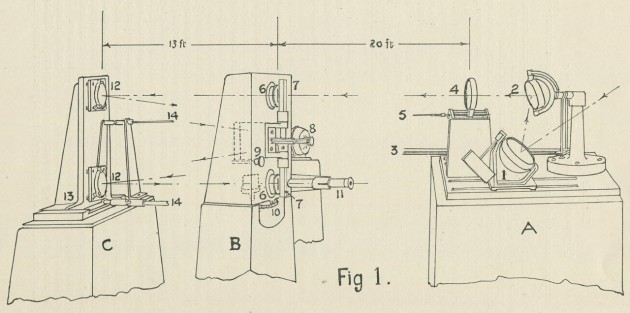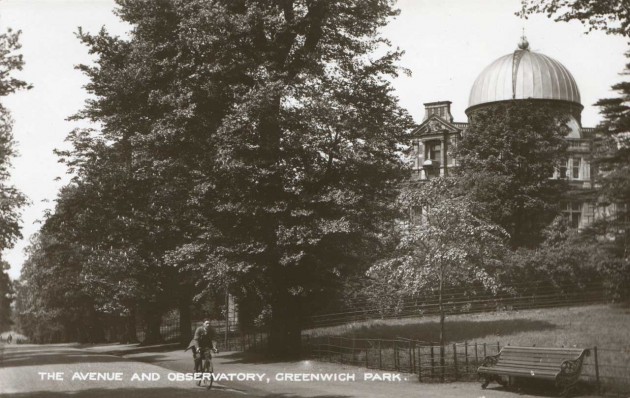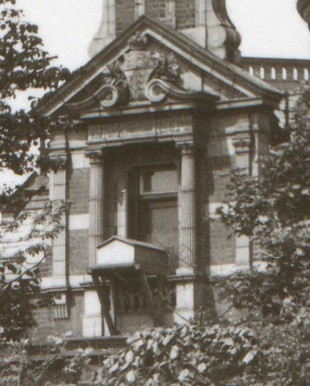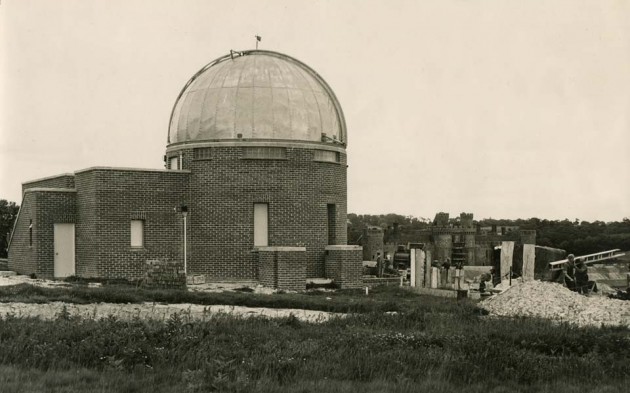…where east meets west
- Home
- Brief History
- The Greenwich Meridian
- Greenwich
(1675–1958) - Herstmonceux
(1948–1990) - Cambridge
(1990–1998) - Outstations (1822–1971)…
- – Chingford (1822–1924)
- – Deal
(1864–1927) - – Abinger
(1923–1957) - – Bristol & Bradford on Avon
(1939–1948) - – Bath
(1939–1949) - – Hartland
(1955–1967) - – Cape of Good Hope
(1959–1971)
- Administration…
- – Funding
- – Governance
- – Inventories
- – Pay
- – Regulations
- – Royal Warrants
- Contemporary Accounts
- People
- Publications
- Science
- Technology
- Telescopes
- Chronometers
- Clocks & Time
- Board of Longitude
- Libraries & Archives
- Visit
- Search
The Greenwich and Newbegin spectrohelioscopes
The spectrohelioscope is an instrument that can be used to study the sun in monochromatic light. It was invented by George Ellery Hale of the Mount Wilson Observatory in 1924.
In 1929, the Mount Wilson observatory lent one of its spectrohelioscopes (complete with coelostat but without grating) to the Royal Observatory. Arriving at Greenwich on 2 October, it was installed in the South Building in the south attic which had been adapted for the purpose. Also installed in the same room was a spectrophotometer, a small spectrograph and an enlarging camera. Observations commenced on 21 November. The Spectrohelioscope was transferred to the new Solar Dome at Herstmonceux in February 1950 where it was installed together with the Newbegin spectrohelioscope. This had been constructed by AM Newbegin from a set of blue-prints supplied to him by Hale shortly after the Greenwich Instrument had become operational and subsequently donated to the Royal Observatory in 1946.

Schematic plan of a Hale spectrohelioscope. A, B and C are normally concrete piers, with A being located outside and B and C in a darkened chamber. At Greenwich, the external components were mounted not on a concrete pier, but on a wooden platform (covered by a wooden enclosure for protection) that was attached to the external wall of the south attic of the South Building. Reproduced from Memoirs of the British Astronomical Association, Volume 37, part 2 (which should be consulted for a full explanation (link below))

The South Building at Greenwich c.1935. The south attic is to the left of the dome. The covered external platform on the outside wall was added when the spectrohelioscope was installed in 1929. The dome was painted with aluminium paint in 1933/4. Postcard published by Daniell Bros., Lewisham

Close up of the external platform at Greenwich. It supported a coelostat, a secondary directing mirror and an object glass (the solar telescope of the spectrohelisocope). Detail from the postcard above
‘An instrument (of the pattern with the Anderson rotating prisms) was lent by the Mount Wilson Observatory to the Royal Observatory Greenwich in the autumn of 1929, Systematic observations of the Sun's disk in Hα were begun within a few weeks and were continued in an unbroken series at Greenwich, so far as weather permitted, till 1950 February, when the instrument was removed for continued service at the Observatory's new site at Herstmonceux Castle, Sussex. At about the same time (1950 January), the spectrohelioscope made on the Hale model by Mr. A. M. Newbegin and forming part of his gift to the Royal Observatory in 1946, had also been erected in the new solar building at Herstmonceux.
During the months following the erection of the Hale spectrohelioscope at Greenwich in 1929, a number of astronomers visited the Observatory, with generous permission of the Astronomer Royal, to see this new and delightful instrument. It is believed that more than one of the British observers, some of whom later acquired spectrohelioscopes of their own, received from these visits a lively inspiration for this field of observation. Up to the time of his death Dr. Hale took a personal interest in the work being done at Greenwich. An important result may be mentioned arising out of the early Greenwich observations and others that were now being made elsewhere, viz. the first published evidence in this country for the close relationship between solar flares (bright chromospheric eruptions) as they were then called and radio fade-outs on long-distance, short-wave communication (see Monthly Notices, 97, 594, 1937). In this work a useful liaison was maintained between Greenwich on the one hand and, on the other, the Radio Research Station, Slough, and Cable and Wireless Limited.
Besides the direct observations of solar flares, absorption markings (such as surges, M.N. 102, 2, 1942) and the related prominences seen in profile at the Sun's 'limb the spectrohelioscope also proved capable of being used with a simple form of visual photometer. Two papers giving results of photometric measures made with the Greenwich instrument were published in 1935 and 1937 respectively (M.N., 96, 5, 1936: 97, 531, 1937). It was something of a minor feat to obtain visually with this little instrument a tolerable contour of the Hα line and the relative intensities of a limited number of prominences in both Hα and Hβ light. With new methods of recording solar flares by the effects of bursts of ultra-violet radiation from flares on the ionosphere, the importance of light curves of solar flares has been enhanced. The measurement of the varying line-width of Hα in emission during the flare has been most usefully developed by Ellison, but up to the present the Greenwich spectrohehpscope has been mainly directed to photometer measures of the central intensity of Hα during the flare, for which a simple wedge photometer has been devised (M.N., 102, 2, 1942). With the dual spectrohelioscopes now installed, side by side at Herstmonceux, it will be possible for two observers to follow the course of the same flare, one making photometer measures and the other line-width measures. A small camera for 35 mm film has also been fixed to the Newbegin spectrohelioscope for photographing at short intervals the Hα line and the adjacent spectrum at times of special activity. From systematic measures of the line-of-sight velocities of dark Hα on the disk, it was pointed out in 1934 (M.N., 94, 472, 1934) that inward motions were more frequently observed than outward motions — a noticeable feature on motion pictures of prominences.’

The Solar Dome at Herstmonceux in 1949. The two piers at the front of the building are on the south side and were built to support the coelostats of the Greenwich and Newbegin spectrohelioscopes which were installed the following year
Further reading
The spectrohelioscope, Memoirs of the British Astronomical Association, Volume 37, part 2 (1952), pp.15–58
© 2014 – 2025 Graham Dolan
Except where indicated, all text and images are the copyright of Graham Dolan